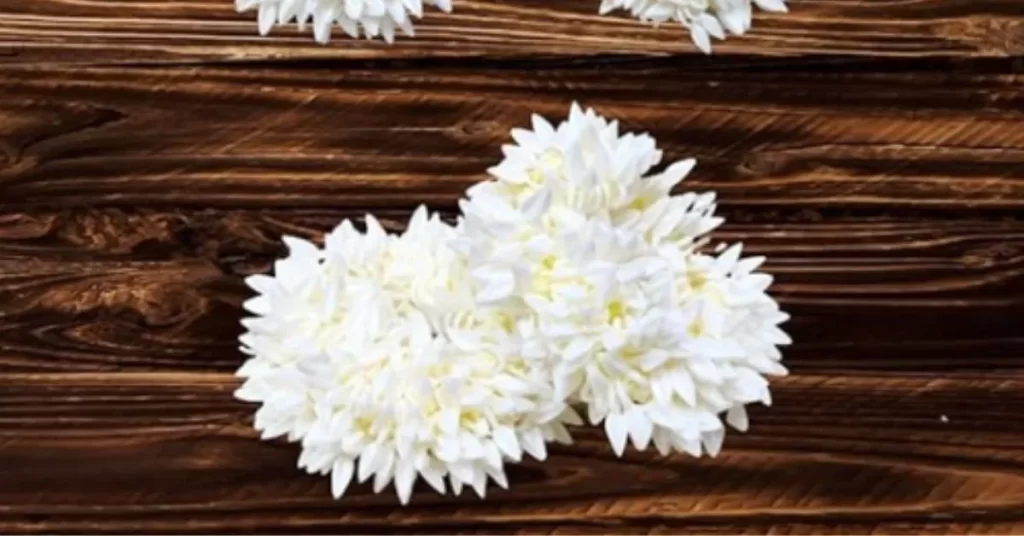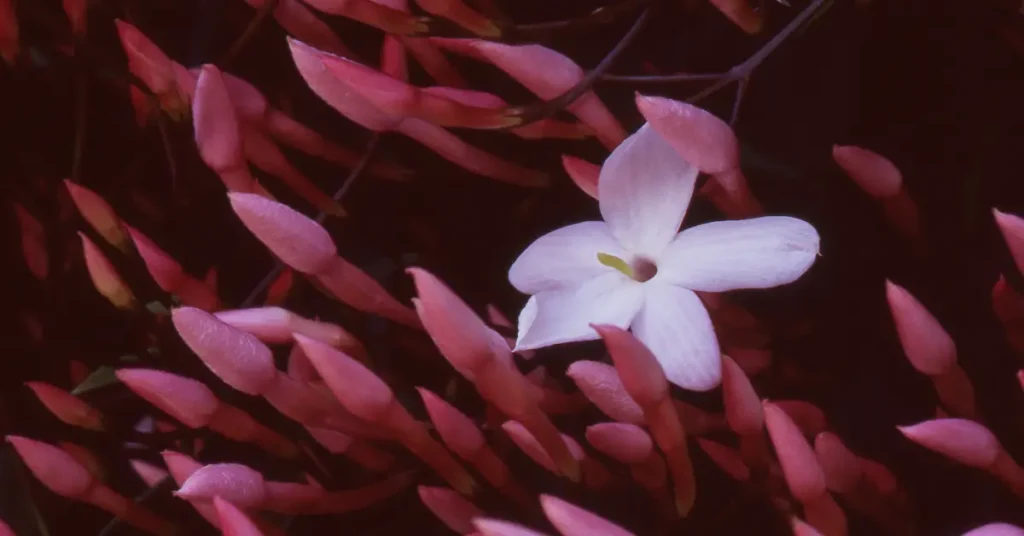Jasminum Azoricum – Lemon Scented Jasmine

Known as the Azores Jasmine and Lemon Scented Jasmine, Jasminum azoricum is an attractive climber with white star shaped fragrant flowers . Originated from Madeira, it is tender and can be grown outdoors in a very mild, coastal location (salt-tolerant and wind-tolerant).
It’s a climber with elegant dark green foliage that grows up to 4m (13 ft). The flower blooms throughout the summer. During summer evenings, they scent the entire garden or even a large terrace. It is perfect for scented gardens, evergreen hedges, terraces, and balconies.
Jasminum azoricum is a member of the oleaceae family. It is native to the Portuguese island of Madeira, where it has become endangered in its natural habitat. While not very hardy like other types of jasmine, this jasmine can grow from its stump after freezing in mild Mediterranean climates. In a mild, southern region, it can grow outdoors on a patio in a sheltered, sunny spot during the summer. For the winter, it is necessary to bring outdoor plant inside to a bright, cool room to prevent frost.
Classification Table
| Family | Oleaceae |
| Genus | Jasminum |
| Species | Jasmine Azoricum |
| Category | Tropical |
| Type | Shrub |
| Origin | Azores, Portugal |
Botanical Characteristics
Growth Habit
With its dark green jasmine leaves, which consist of three wavy-edged ovate leaflets, and 2.5cm-wide white flowers, this evergreen shrub reaches heights of 3 to 4 meters. A characteristic feature of the plant is its slender stems, which are somewhat woody at the base and tend to trail. It takes at least three months for it to flower in moist soil, from June to September. Fencing, pergolas, arches, and walls benefit from the coverage provided by Jasminum azoricum.
Leaves
The leaves are opposite, evergreen, leathery, trifoliate, glabrous, and shiny, with ovate to ovate-lanceolate leaflets. There are green, angular, or channeled young branches bearing foliage. This evergreen plant has pinnate leaves that have seven leaflets, which are dark green and glossy. The stems become woody, light brown, and leafless.
Flowers
It bears numerous paniculate inflorescences with dark pink buds that open into pure white star-shaped flowers with five long and slender petals, 2cm in diameter. Flowering occurs throughout the year in warm climates, starts in spring and lasts almost all year long. Its strong, but not overwhelming, fragrance evokes orange blossom. Jasmine flowers attract butterflies and other pollinating insects.
Fruit
Even though Jasmine azoricum produces black, small berries after flowering. The most valuable ornamental feature of this plant is usually its foliage and flowers, rather than its fruit.
Planting Jasmine Azoricum
This lemon scented jasmine can climb over bushes, fences, arches, pergolas, stair railings, terraces, or balconies in climates suitable for it. It is best planted in a container on a terrace. This vigorous climber can quickly cover a trellis-adorned wall. It can be combined with another climbing plant, such as Clematis cirrhosa, Jasminum nudiflorum, or Ampelaster carolinianus, in the ground or in containers on the terrace.
Azores Jasmine is highly valued in landscaping, although it is difficult to find. Its fine and delicate texture, along with its fragrant white flowering, enable it to fit into many types of gardens, from English gardens to French to Italian to tropical. Furthermore, it grows moderately and requires little maintenance after establishment, except for pruning to maintain its shape.
Ideal Growing Conditions
Light Conditions
Like Arabian jasmine, Azores jasmine grows best in full sun or partial shade. Direct sunlight should be provided to the plant at least six hours per day to produce abundant flowers. Even in hotter climates, it tolerates light shade, since too much sun may cause the jasmine leaves to scorch.
Soil Requirements
Ideally, Jasmine azoricum thrives in well-draining soil that is rich in organic matter and irrigated regularly in the first year after planting. It prefers a neutral to slightly acidic pH, but it is not particular about soil type as long as drainage is good.
In the case of heavy, waterlogged soils, compost or well-rotted manure should be incorporated to improve the soil’s fertility and structure. Furthermore, it is resistant to frost, cold, winds, and salinity of coastal areas, making it suitable for climates across the globe.
Watering Needs
Lemon Scented Jasmine need regular watering in warm weather. Winter days are cooler, so your plant will require less water, so water once the top inch of soil is dry. Maintain a constant moisture level in the soil without allowing it to become soggy.
It becomes more drought-tolerant once it is established, but it still benefits from occasional deep watering when it is dry. In winter, when the plant’s growth slows, watering should be reduced to prevent waterlogging and root disease.
Temperature
The ideal temperature range for Jasmine azoricum is 15°C to 25°C (59°F to 77°F). Extremes of heat or cold do not suit it well. It thrives in subtropical climates with high humidity levels. It turns black when the temperature drops below -6°C (21.2°F).
Plant Care
Propagating Jasmine Azoricum
Cuttings of semi-woody branches are used for propagation. These cuttings are taken in late spring and throughout the summer and planted to root in a sandy substrate while keeping them moist. Plant the cutting in a potting mix that drains well and contains equal parts perlite and peat moss.
Warm, humid conditions with indirect light are best for the cutting. Use a plastic bag to cover the cutting.
Air layering is another method of propagation.
For healthy growth and full bloom, use fertilizers.
Pruning
Jasmine azoricum is a climber that needs pruning regularly in order to keep its shape and stay in control. When planting climbers, train and prune as soon as a twining habit is established, and pruning is less frequent once the twining habit is established.
To improve air circulation and light penetration, thin out some of the inner branches if the plant gets too dense. The plants usually recover after being cut back fairly hard in late winter, but it may take a while for them to do so.
Pests and Diseases
Aphids
They are sap-sucking insects. Plants suffering from sap-sucking may lose their vigor, grow incorrectly, and produce honeydew on which sooty molds can grow. Aphids can transmit viruses to plants. Use insecticidal soap or spraying the plant with water can control them.
Mealybugs
If the plants are covered in a white, waxy secretion (masses) around the base of leaves, stems, or buds, Its time to worry because they are mealybugs. Mealybugs can stunt the growth of Jasminum azoricum and cause yellowing or wilting of leaves. If the infestation is severe, affected plants may shed their leaves prematurely.
For small infestations, you can manually remove mealybugs by gently wiping the affected areas with a cotton swab dipped in rubbing alcohol (isopropyl alcohol). This will kill the mealybugs on contact.
I always advise Insecticidal soaps or horticultural oils application on the affected areas. These products suffocate the mealybugs and are safer for plants and beneficial insects.
Read: Insect Pests Pictures and Their Control
Spider Mites
Spider mites are small, red insects that thrive in dry conditions. Their presence can result in speckled and webbed leaves. The use of neem oil or horticultural soap can help control these pests.
Root Rot
Overly wet or poorly drained soil causes root rot. It is important not to overwater plants and to make sure that the soil drains well in order to prevent this disease.
Jasminum Azoricum Uses
Aesthetic Value
The Jasminum azoricum plant is grown as an ornamental plant in gardens and parks. This plant is a great choice for trellises, arches, and walls due to its lush foliage, climbing habits, and fragrant flowers. You can also use it as a ground cover in large landscapes or train it as a small tree or shrub.
Fragrance
Flowers of this plant have a sweet, lemony scent, making them a popular choice for sensory gardens, patios, and courtyards. Fragrant flowers are used in perfumery and flavoring tea. Its essential oil is used in both perfumery and cooking.
Container Planting
Jasmine azoricum can be grown in large containers and brought indoors during the winter in colder climates. This plant is a wonderful addition to sunrooms and greenhouses because of its evergreen foliage and fragrant flowers.
Final Words
Jasmine azoricum are versatile and beautiful additions to any garden, especially for beginner home gardeners and those looking for an easy-to-grow plants. This shrub’s fragrant blooms, evergreen foliage, and climbing habit make it an ideal choice for adding vertical interest, concealing unsightly structures, or simply enhancing a patio garden with its sweet scent.
You will be rewarded with growth, dense foliage, and captivating flowers whether you grow them in the ground or in containers. If given proper care, Jasmine azoricum can flourish in a wide variety of climates, adding beauty and elegance to any landscape.

I am Yasir Riaz, an Agronomist for more than a decade. Helping local farmers and Gardeners to improve their crops and Gardens and overall productivity. In addition to my work in agriculture, I have also delved into the digital world as an SEO writer and blogger. Through my blog, I aim to educate and inspire others about the Chameli Flower (Jasmine).






